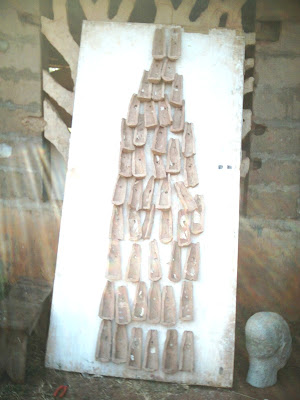
Wednesday, January 31, 2007
BRAIN DRAIN
 Alozie C. Chibuike. Brain Drain. 2006. Clay.Brain Drain, 170cmx170cmx20cm.
Alozie C. Chibuike. Brain Drain. 2006. Clay.Brain Drain, 170cmx170cmx20cm.In this work, there is also an scattered assemblage of clay works, that have been pierced and
cut into half.
The clay works actually represent fruits of avacado pears that have been have been hollowed and split into half. It is an art work that metaphorically potrays the 'brain drain' syndrome that has been haunting the country for a long time now, where a large number of Nigerian citizens travel out of the country to become citizens of foreign countries. Through this artwork, the artist tries to express the fact that it is not just individuals that leave the country for the so called 'greener pastures but on the general scale the country is being drained of thousands upon thousands of human resources who individually have the potential to transform the country into the green pastures they seek, our lame political and socio-economical strides towards development notwithstanding.
BOTTLES

Alozie C. Onyirioha. Bottles. 2006. Clay on board. 244cm x 9cm.
The artwork, bottles is an assemblage of "halved" green ware bottles fastened onto an upright square wooden pedestal. The bottles all seem to be placed in a way that they generally assume the form of a whole bottle.
The artwork alludes to the ancient Chinese adage that states: " a full bottle won't shake, but a half one will". Things don't always seem to be what they appear and just like the overt picture of the bottle portrays a full structure, its individual parts reveal small, empty halves that finally affirm the fact that it is not as stable as it is meant to be. Nigeria is popularly regarded as the Giant of Africa due to our geometric and population size and our natural and human resources, but our political and socio-economic policies and the nature and attitudes of our leaders over the last forty years showcase a pattern that reveals a "halved" and "empty" effigy of the democratic ideal.
Barricade
 Alozie .C. Onyirioha. Barricade.2006. Clay(Greenware) , Binding Wire.390cm x 9cm.
Alozie .C. Onyirioha. Barricade.2006. Clay(Greenware) , Binding Wire.390cm x 9cm.By passing a long stretch of binding wire through different sizes of greenware clay slabs, the artist has attempted to use this artwork, Barricade, which is a crude creative imitation of the restricting structures used by most institutions like road safety marshals and dectectives to ward of motorists from accident scene or onlookers from a crime scene, to metaphorically represent a type of fortress or enclosure which saliently announces the existence of something valuable within its precinct, like the number of artworks artworks in his exhibition.
AKPAJA (PUNCHING BAG)

Three longtitudinal pouches of clay suspended from the horizontal bar of a swing-like wrought iron structure characterises this work of art.
Akpaja, lliterarily translated to mean sandbag or punching bag, is a piece of instalmental sculpture that metaphorically issues out a silent satarical diatribe against the attitude of the Nigerian politicians who , like the boxer that hurls his punches at random on the punching bag, aim their selfish, myopic and shallow policies at the general nigerian populace, nonchallant and oblivious of their resultant effect on the economy.
AKARAKA
 Alozie C. Onyirioha. Akaraka. 2006. Clay(Greenware). 244cm x 120cm.
Alozie C. Onyirioha. Akaraka. 2006. Clay(Greenware). 244cm x 120cm.The work Akaraka comprises of several slabs of unbaked clay (greenware) with imprints of a palm depressed into their respective surfaces. the works are installed on a wall in a pattern that assumes the crude semblance of a cross.
Akaraka, which means 'destiny' in the Ibo language, reveals a fresh insight on the peculiar nature and rite of passage of the individual's quest in discovering his or her potentials and purpose. The palm-prints is a type of synechdochal expression that posits the notion that ones inherent gifts or talents gives a clue on the direction of ones destiny. Sometimes we express our respective talents or stumble upon them by way of chance occurences in life, in our attempts at different vocations or in the living out of our various proffessions all in the bid to knowingly or unknowingly search out and fulfill our respective purposes, to walk the varied and unique paths of our destiny.

,+16cm+x+20cm,++2006,+Alozie+Onyirioha.JPG)



